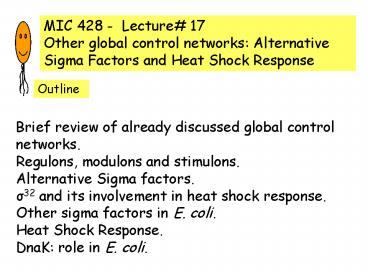MIC 428 Lecture PowerPoint PPT Presentation
1 / 33
Title: MIC 428 Lecture
1
MIC 428 - Lecture 17 Other global control
networks Alternative Sigma Factors and Heat
Shock Response
Outline
Brief review of already discussed global control
networks. Regulons, modulons and
stimulons. Alternative Sigma factors. s32 and its
involvement in heat shock response. Other sigma
factors in E. coli. Heat Shock Response. DnaK
role in E. coli.
2
Outline continuation
Two component regulatory systems. Regulation of
chemotaxis, steps and proteins involved.
3
From last class
Organisms have global control systems that
regulate many genes simultaneously in response to
a specific environmental change.
4
Global control systems allow an organism to
respond effectively to signals in its environment.
Catabolite repression.
Quorum sensing
5
Catabolite repression
and its consequence, diauxic growth.
Remember that catabolite repression works through
the control of transcription by an activator
protein, CAP, bound to cAMP (Lecture 16).
6
As long as glucose is present, catabolite
repression prevents expression of all other
catabolic operons under this global controlling
element.
7
Quorum sensing (or autoinduction)
Environmental sensing system that allows bacteria
to monitor their own population density.
A small diffusible signal molecule (the
autoinducer) interacts with a transcriptional
activator protein to couple gene expression with
cell population density.
8
Regulons, modulons and stimulons
Regulon
More than one operon is under the primary control
of the same regulatory protein (ex. the maltose
operon)
Modulon
Group of genes that can respond to a common
regulatory protein even though they may also be
members of different regulons
Stimulons
Group of genes hat all respond to the same
environmental signal. Large group of genes and
very complex regulatory pathways.
9
Alternative Sigma Factors
Do you remember what sigma factors are?
You may consider reviewing chapter 7, section
7.8, overview of transcription.
Regulation happens by changing either the amount
or the activity of these factors.
10
Subunit of the RNA polymerase responsible for
promoter recognition.
11
s70
Genes that are induced by an increase in
temperature (heat shock)
s32
Seven different sigma factors in E. coli (see
table 8.2 in your textbook)
12
Heat Shock Response
s32 is rapidly degraded but when cells
experience a heat shock, this degradation process
is inhibited.
More sigma factor. More RNA polymerase directed
to more heat shock promoters.
13
In global regulatory systems, there is always a
common way to transmit a signal from the
environment to the gene (cAMP, AHLs).
How do bacteria sense an increase in temperature?
14
Heat shock proteins
DnaK
Chaperonin Molecular chaperones
15
DnaK
Helps other proteins fold properly Involved in
the degradation (and also inhibiting the
activity) of s32
16
Two-component regulatory systems
Environmental fluctuations
Temperature changes pH and oxygen
availability Nutrient availability
How do bacteria sense these signals?
17
How do bacteria sense these signals?
External signal
sensor
Signal transduction
18
2-Component Systems
Signal
ATP
ADP
D
H
Altered Cellular Response
Histidine Kinase
Response Regulator
Slide by Dr. Lisa Alex
19
Transcription either blocked or expressed
20
Where are 2-Component Systems Found?
- Bacteria (absent in parasitic bacteria)
- Plants
- Fungi
- Slime molds
- Note They are not found in mammals!!
21
Basic Domain Structure of a Histidine Kinase
Approximately 250 amino acids in
length Contains several conserved sequence motifs
H
N G1 F G2
ATP binding site
H box site of autophosphorylation
Slide by Dr. Lisa Alex
22
Basic Domain Structure of a Response Regulator
Minimum of 120 aa Conserved spacing of
hydrophobic residues
D
D
K
Phosphorylated aspartate
23
Responses Mediated by 2-Component Systems
- Bacteria
- Adaptation to changing osmolarity
- Sporulation
- Chemotaxis
- N2 metabolism
- Redox status of cell
- Light
- Virulence and many more!!
Slide by Dr. Lisa Alex
24
Regulation of Chemotaxis
Step one Response to signal
Step two Controlling flagellar rotation
Step three Adaptation
25
Proteins involved in chemotaxis
Role
Protein
Receptor Senses attractants and
repellents CheA Histidine Kinase CheY Respon
se Regulator (binds to switch) CheB Response
Regulator (methylesterase) CheR Methylates
COOH groups on Receptor (adaptation) CheZ Ph
osphatase (Hydrolyzes CheY-P)
Slide by Dr. Lisa Alex
26
(No Transcript)
27
Che-Y-P interacts with the flagellar motor
Clockwise rotation
Che-Y cannot interact
Counterclockwise rotation
28
Step three Adaptation
Is the feedback loop necessary to reset the system
29
(No Transcript)
30
To summarize
Regulation of gene expression
Control of enzyme activity Control of the amount
of enzyme post transcriptional and post
translational. Global control systems
31
Control of enzyme activity
After the enzyme has been produced
Post translational control
Feedback inhibition, allosteric regulation,
isoenzymes, covalent modification
Control of the amount of an enzyme
At the level of transcription
At the level of translation
32
Control of the amount of an enzyme
At the level of transcription
Negative control
Positive control
Repression
Induction
Arginine Operon
Maltose Operon
Lactose Operon
At the level of translation
Tryptophane Operon
Attenuation
33
Global control systems
Catabolite repression Quorum sensing Alternative
sigma factors and heat shock response Two
component regulatory systems and regulation of
chemotaxis

